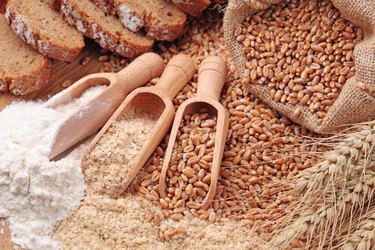
With buzz words like "bran," "multi-grain" and "enriched" on many food labels, it's often difficult to distinguish the differences between types of grains and even between different parts of the same type of grain.
But whole grains are important because they provide fiber, vitamins and minerals and can even reduce the risk of certain chronic health problems such as diabetes and colon cancer. Whole wheat and wheat bran are both very healthy and should be included in your diet as often as possible, but they have a few differences.
Video of the Day
Video of the Day
Related Reading
Structure of Wheat Grain
"Whole wheat" or "whole grain" means the three parts of the grain — the bran, endosperm and germ — are kept intact when processed and eaten. Each part of a wheat kernel has different nutrition benefits.
Thus, wheat bran is actually a part of the whole wheat kernel. It's the outermost layer that protects the endosperm and germ and is often removed when the wheat kernel is processed.
Function in Foods
While wheat bran is commonly supplemented in a powder form and added to drinks, smoothies and cereals, whole wheat is used whole in products like breads and bagels.
Whole wheat has a greater variety of applications in foods because the bran, endosperm and germ each have different textures and qualities. But bran is often taken out of a food product during processing because it doesn't produce as much of a soft, desirable texture in foods as the endosperm.
Nutritional Benefits
The bran of the whole wheat kernel is rich in minerals like copper, selenium and manganese. Wheat bran also has phytochemicals which can help to prevent certain types of cancers.
Since bran is rich in fiber, it also adds bulk to stool weight, acting as a mild laxative. But both bran and whole wheat can function in the body to promote bowel regularity.
As whole wheat kernel includes the bran, all the nutritional benefits of bran are included in 100-percent whole-wheat products. In addition, the whole wheat kernel has the endosperm, which contains some starch, vitamins and minerals, as well as the germ, which has healthy oils and B vitamins, used for energy.
Storage and Shelf Life
Whole wheat comes in many forms such as flour, bread, pasta and bagels. These products all have similar shelf lives as their refined "white" counterparts and don't rot quickly. They may be stored on the counter or in the fridge, but occasionally check for signs of rancidity such as a change of colors or an off odor.
In contrast, wheat bran has a high oil content, so it can go bad very quickly. Wheat bran needs to be stored in a cool, dark place such as the back of a cupboard or the fridge.
Which One Is Better?
There's no concrete answer as to whether whole wheat or wheat bran is better, as they both have comparable uses and nutritional benefits. Whole wheat may be a better choice for one person, while wheat bran may be a better choice for another person, depending on taste preferences and nutritional needs.
Wheat bran would probably be a better choice for someone who needs a lot of fiber such as a person with diverticulitis. But whole wheat may be a better choice for someone (ex. a vegan) who doesn't get a lot of B vitamins from other foods.